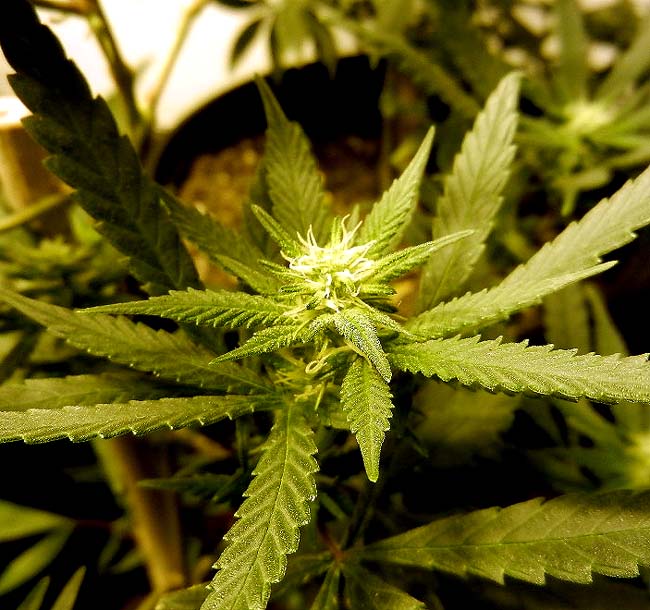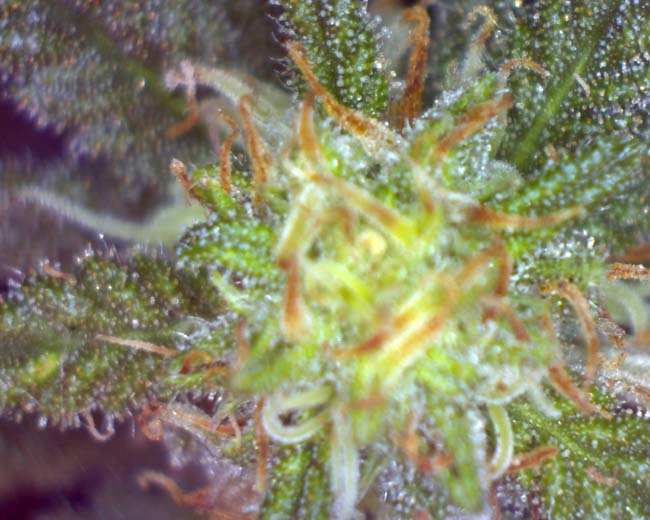August 28th: Week 1 (Flowering)
Picked up a 17" Holy Grail Kush clone in a 1 gallon container.
Transplanted it to a 2 gallon nursery pot and began LST to open up and spread
out the canopy. The free hanging weights stimulates the plant into strengthening
its limbs making for branches that carry more and heavier buds. I also
'super cropped' several of the top nodes to train them out and downwards.
This is done by pinching the branch until it droops. It will regrow with a
knuckle and a stronger limb as well. This will be the tallest plant (13 nodes)
that I have put to flower.
Currently it is in the vegetation chamber under a 125 watt CFL top light
with 112 watts of T5 side lighting - both sets of lights in the soft white
(2700K) spectrum except for 2 of the T5's left in the daylight (6500K) spectrum
to assist in non flower growth.
This strain is reputed to be very aromatic ('stinky') and so will be transferred
to the flowering chamber under HPS for the last 30 days of flowering. A plant
this tall should easily be able to produce an ounce or more. If this is successful
I will purchase more of these 'teen' plants which have already vegetated
for 30 days or more and can be flipped immediately. The flowering chamber
can accommodate at least 3 plants this size. Even though they cost twice
the amount of the smaller 6-8" clones there is a savings of at least 30 days
of 24 hour electrical charges incurred during vegetation.
September 6th: Week 2 (First flower)
Decided to combine all 5 plants (Grows 8,9,10) in the flowering chamber and
lowered the shelf so that the Holy Grail is 8" below the lights. The
other plants were set on top of #2 nursery pots bringing the Diamond OG clones
within 8 inches as well and the shorter Bubba Kush clones are at 10 inches.
I still haven't found the authoritative answer as to height
under HPS bulbs -
Wikipedia says "
Often,
the distance between lamp and plant is in the range of 0.6 m (2 ft) with
high pressure sodium lamps, to 10 cm (4 in) with other lamps, such as compact,
large and high output fluorescent lamps".
Most of the pictures of online grows show a similar distance but many commenters
say that 8-12" is acceptable with the smaller 250 watt HPS. They will be
left at this height but carefully observed for leaf burn or light bleaching.
September 13th: Week 3 (Flowering)
Plant is in full flower with a total of 30 or more bud sites averaging 3
per branch. It's obvious this was not one of the short and stocky Kushes
and perhaps stretched more than necessary during the vegetative stage before
I obtained it because internode spacing is over 2 inches.
The plant is continuing to be festooned with metal fence ties weighing down
the branches as a form of weight resistance training - with each flex of
the branches in response to the oscillating fan they grow stronger and will
better be able to support their future heavy buds. Depending on how heavy
those buds are additional support stakes may be needed as well.
September 20th: Week 4 (Flowering)

Holy Grail Kush flower at 23 days. Many new pistils in just the last couple
of days as the flowers start to build and stack their calyxes (ovaries) -
there are two pistils per calyx which are the external pollen receptors.
In this image I boosted the contrast to show the light dusting of trichomes
(resin glands) which contain the psychoactive properties of the plant and
serve to protect the leaf surface from desiccation and insect damage.
(Flowering)
Decided that this plant was too crowded on the shelf among the other plants
in the flowering chamber so moved it back to the (modified) vegetation
chamber under 200 watts CFL overhead and 112 watts T5 vertical side lighting
- all in the 2700K flowering spectrum.
The overhead bulb outputs 12,000 lumens boosting the total in the grow room,
when combined with the 10,800 lumens from the vertical T5HO lights to a total
of 22,800 lumens. This is only 4700 fewer lumens than in the flowering
chamber with its 250 watt HPS bulb. The side lighting is especially useful
with a tall plant as is this one.
The flowers are really starting to elongate with multiple stacking calyxes
and abundant pistils. I expect they will put on most of their growth during
the next two weeks and should become quite aromatic. This is the largest plant
I've grown so far and part of the relocation impetus was a desire to observe
it more closely.
9-28: I was wondering this morning why this 'indica' cross was so lanky and found the
answer:
"Known Phenotypes:
1.: short, compact, fastly blossoming, indica-dominant Phenotype #2
2.: long, stretched, slowly blossoming, sativa-dominant Phenotype #1"
It's obvious that this plant is the sativa dominant Phenotype #1 which also
means that it is definitely not an early flowering variety maturing during
the 9th or 10th week or possibly even later. Could be that its effects are
more sativa like as well i.e. cerebral versus somatic.
9-29:

Here is an image of the developing calyxes and pistils - notice about 30%
of the pistils have begun to mature and darken. The trichomes are still
quite immature and appear as a light dusting on the flowers and leaves.
9-30:
Found this article on the advisability of
removing most of the fan leaf
after the 4th week of flowering on Kush strains. The claim is that the plant
no longer needs them and they would have dropped off in nature by that time.
Retaining them only drains nutrients better directed towards building flowers
than leaf at that stage. The plant's nutrient needs can be met by the fully
developed root system unlike a plant still in the vegetative stage.
Accordingly all the current plants, being Kushes, were "stripped to sticks
with just a few fan leaves, but with all of the budding sites intact" as
the article suggests. Added inverted paper plates as container covers to
help retain soil moisture and reflect light up to underside of plants.
October 4th: Week 6 (Flowering)
Currently in the middle of a heat wave with outside temperatures in the
80's to 90's through the weekend. Shifted all plants to the vegetation chamber
and installed the A/C in the flowering chamber using the exhaust fan to vent
the extra heat. Since the two chambers are on opposite sides of a common hallway the doors between
them are left open during the day making, in effect, one contiguous chamber.
10:00 am: Inside grow room temps over 86 already and the A/C can no longer
could keep up. All plants moved to the front of the coach under the surround
windows and overhead fan which is just as acceptable and quite a bit more
energy efficient.
With another fan and the outside door open plus a little cross ventilation
the temps are 84F. This is their first exposure to direct
sunlight ... will have to get a good light meter to see if the lumination
equals that of the grow chambers.
Certainly there is enough light to carry
the plants through the next couple of days.